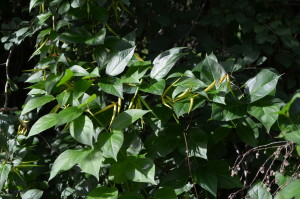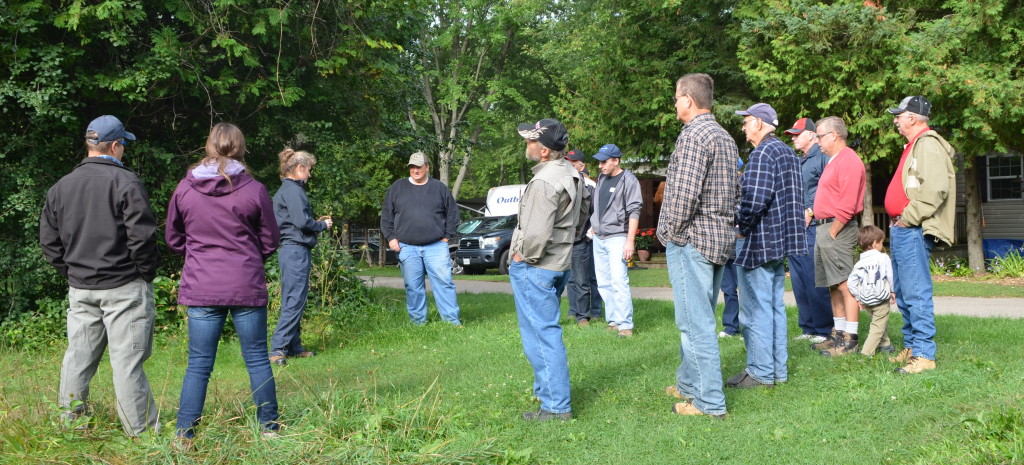At a recent outing of the Huron Perth Woodlot Association, members were lead on a woodland hike by Brenda Gallagher of the Upper Thames Conservation Authority (UTRCA) as a follow-up to the chapter AGM where Brenda spoke about invasive species. While the focus of the hike was invasive species, she also pointed out other species and discussed their history, ecology, folklore and medicinal properties. UTRCA generously provided access to their Wildwood Conservation Area near St. Marys for the event.
As with many sites across southern Ontario, Wildwood was heavily infested with European (common) buckthorn. It is on Ontario’s noxious weed list, primarily because it is an alternate host to the oat rust fungus. It seeds prolifically, annually bearing a heavy crop of black berries. . Its Latin name Rhamnus cathartica relates to the cathartic (laxative) effect the berries have on whatever ingests them. Birds feeding on the berries quickly spread the seeds far and wide. A cousin, glossy buckthorn, is also invasive in woodlands in parts of southern Ontario. Apparently glossy buckthorn was planted in some areas in the 1800’s and early 1900’s since burning the wood produced charcoal with ideal characteristics for manufacture of black powder (gunpowder). Control of buckthorn is best carried out with appropriate herbicide applied as a basal bark treatment to standing trees or to freshly cut stumps.
Another invasive plant the group saw was dog-strangling vine, a relative newcomer to Perth County. It has the ability to overwhelm existing natural vegetation. Currently the only means of control is repeated application of appropriate herbicides. Gallagher said a caterpillar that feeds exclusively on dog-strangling vine had recently been released in the Toronto area. Hopefully it will be as successful as the beetle released several years ago to provide control of purple loosestrife, another non-native invasive.
Along the trail Gallagher pointed out a number of interesting plants and presented a variety of information about them. In a wetter location she identified several skunk cabbage plants and was able to show the group remnant leaves and seed pods. Skunk cabbage gets its name from the skunk like odour it gives off when flowering or when the leaves are crushed. It actually starts growth and flowers in late winter, usually when there is still snow on the ground. It is a thermogenic plant, which means it has the ability to raise its temperature several degrees above the surrounding environment through cellular respiration ( thermogenesis). Carrion flies and other insects are attracted into the flower by the odour and higher temperatures. They reciprocate for the warm place to stay by providing pollination services.
Participants were shown several species of plantain that are common in both natural and disturbed areas. Plantain is reported to help reduce inflammation and itching from rashes, insect bites and stings. It is also said to help healing of wounds. A mashed up poultice of the leaves can be placed directly on the affected area. She also showed the group the common woodland plant, jewelweed (also known as touch-me not or impatiens). Many people believe the sap from mashed up jewelweed will help relieve symptoms of skin problems such as sunburn and poison ivy.
Gallagher really caught the group’s attention when she described how to make a tincture of hawthorn berries by chopping them up and placing them in a container, then covering them with vodka. After a few weeks the liquid is drained off and kept as the tincture which is administered orally as needed. Hawthorn apparently has benefits for heart health. Several folks seemed quite interested in trying this process.
As the group stopped under an elm tree Gallagher described how elms had often been used as outdoor meeting places throughout history and planted outside courtrooms as symbols of justice prior to devastation by the Dutch elm disease. She also explained that natives in our area had often used elm bark in making canoes due to a lack of birch trees in our local forests. Apparently they were taunted during interactions with nearby groups that had faster and lighter birch bark canoes. She laughed about how people are similar today, only now they may be envious of others who have nicer cars or pickup trucks.


